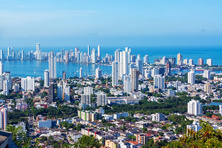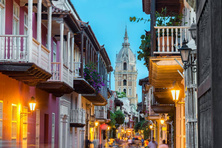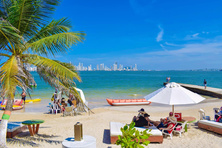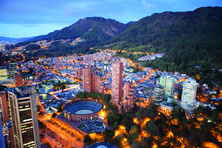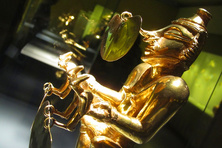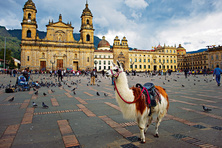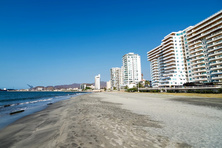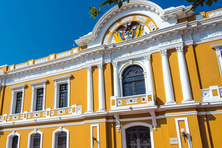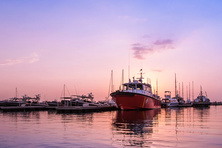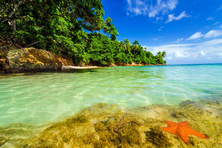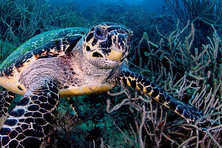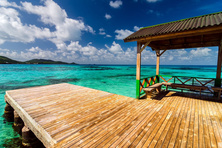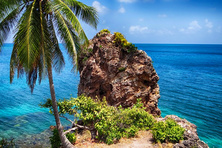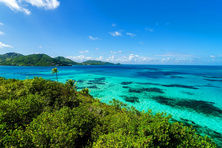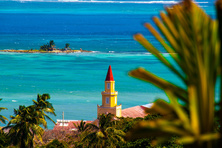Colombia
- Capital:Bogota
- Currency: Colombian peso
- Time: UTC-5
- Languages: Spanish
- Religions: Christianity (Catholicism)
- Sections: Get in Visa Customs Cuisine Money Details of interest Popular resorts
Colombia or officially the Republic of Colombia is a state in the South America. It borders Brazil, Venezuela, Ecuador, Peru, and Panama. The northern part of the country is washed by the Caribbean Sea and the western part by the Pacific Ocean. The capital of the country is Bogota.
Columbia has mainly equatorial and sub-equatorial climate but in the American Cordillera the climate is mountain. The temperature and the amount of precipitations do not change much during the year, so you can plan your travel to Colombia all the year round.
The locals speak Spanish which is the official language of Colombia. The main religion here is the Catholicism.
The tourists come to Colombia to enjoy its nature and landscapes with great mountains, rapid rivers, blossoming valleys, exotic animals and plants. Some tourists travel to Colombia to spend their holidays at luxurious resorts of the Caribbean coast or get to know the history and the culture of Colombia better.
The main beach resorts in Colombia are San Andres Island and Providencia Island and the city of Cartagena.
If you travel to Colombia, you should see historical and architectural monuments in such colonial cities and Popayan and Cali.
There is a great variety of reserves and natural parks in Colombia. The most famous are the national parks La Macarena, Los Katios and Chiribiquete. On the east of Columbia, there is a large touristic center Leticia which is world famous for its island of monkeys Isla de Los Micos.
Near the Medellin, there are numerous trekking routes. In this part of the country, there are all you need for rafting, climbing and paragliding.
If you like ethnic festivals, you will be impressed by the carnivals in Pasto and Barranquilla.
Get in
By Plane
There are no direct flights between any of CIS countries and Colombia. You can fly to the country with a stop in Europe or the USA. Air France offers the most convenient flight with a stop in Paris or Iberia with a stop in Madrid. The Colombian capital is linked with the major airports of the North American countries.
By Land
A comfortable travel to Colombia by land is possible only from Venezuela or Ecuador. The safest way to cross the border with Ecuador is near the city of Ipiales. On the Venezuela border, the safest route is through Cucuta. You can get to Brazil and Peru by boat through the city of Leticia but this place is too remote from the major transport routes of all the three countries.
By Sea
The border with Panama is believed to be almost impossible to pass. For this reason, the tourists prefer to travel by plane or by sea. There are quite many companies which can arrange short cruise trips between the neighboring states.
Visa
The tourists from Russia and the European Union can stay in Colombia without a visa for 90 days. The citizens from CIS countries and Russians who are planning to stay in the country for more than 3 months must obtain a visa in the Embassy in Moscow.
Normal visa processing time is 3-15 working days. You can submit the documents personally or through a trusted person.
Customs
There are no restrictions concerning import and export of foreign or national currency in Colombia. However, the cash in the amount of 10.000 US dollars and over must be declared.
You can import the following goods in Colombia duty-free:
- a small amount if alcohol and tobacco;
- perfume for personal use.
It is strictly prohibited to import:
- vegetables, plants and materials of plant origin;
- meat and meat foods;
- some breeds of dogs;
- art objects;
- antiquities and archaeological valuable goods.
It is prohibited to export from Colombia:
- skins of wild animals and stuffed wild animals;
- art objects;
- antiquities and archaeological valuable goods;
- any souvenirs without a receipt;
- emerald or gold and platinum jewelry without a special export label.
Cuisine
The Colombian cuisine is a combination of traditions of the Indians, Spanish settlers, and people from Asia. The staple foods in Colombia are beans, corn, rice and meat.
Colombia is not a very attractive country for gastrotourism but it can offer many delicious meat dishes such as Bandeja Paisa (meat mix with beans, fried bananas or rice as a side-dish), Lechona (grilled pig stuffed with rice and spices) and Sobrebarriga (local hot beefsteak).
We also recommend the Colombian chicken sausages Chunchulo and scrambled eggs with tomatoes Huevos Pericos.
The Colombians also eat soups, for example, Ajiaco (thick chicken soup with potatoes and yucca); Mazamorra (meat soup with flour) and Sancocho de Gallina (chicken broth with corn).
Being in Colombia, treat yourself to Cazuela de Mariscos (a stewed mix of seafood).
Beans, rice and corn are a traditional side-dish for the Colombians. The locals eat a lot of tropical fruits and vegetables and use them as ingredients for very delicious dishes such as Platano (fried bananas) and Papas Choreadas (fried potatoes with tomatoes and cheese). You will not be served traditional European bread, instead the Colombians will offer flatbread Arepa and Tamales.
The desserts which you should try in Colombia are Arroz Con Coco (rice with coconut milk), Manjar blanco (vanilla milk), Natilla (pastry with custard) and El Carmelo (fruit pie).
In Colombia you will see both known fruits and exotic ones such as naranjilla, mamoncillo, guama, borojo, pomarosa and pitaya. They make very delicious drinks from these fruits. Do not miss a chance to try Colombian fruit mixtures with ice Chichas. The locals also like to drink coffee, a popular in Latin America tea Mate and other herbal drinks which they call Aromatikas.
In Colombia, the produce an excellent rum, an unusual bread vodka Aguardiente and a traditional Indian drink Chicha.
Money
Colombian peso (COP) is official currency in the country. The bank notes from 5.000 to 50.000 COP and coins from 50 to 1.000 COP are in circulation.
The tourists can exchange currency at the airport at arrival, at banks, in exchange offices, hotels and large stores. The exchange rate in hotels and stores is insignificant and the rate in exchange offices is usually the same as at banks. Many large stores accept US dollars which is particularly beneficial if you buy jewelry. But in other situations, we recommend paying with the local money.
In Bogota and at the resorts, you can pay with an international credit card. However, if you are planning to visit small towns, you will nit be able to pay with your card.
You can cash your traveler's checks only in the Central Bank of Colombia and its offices. You will face problems using the traveler's checks outside Bogota.
In Columbia, the level of criminal activity is rather high but if you observe simple safety measures, you will avoid dangerous situations.
Details of interest
Sightseeing in Colombia
Colombia has 8 sites from the UNESCO World Heritage List and the tourists can visit them all:
- Port, Fortresses and Group of Monuments in Cartagena is a unique example of port fortifications of the colonial era.
- Los Katios is a National Park with a great diversity of flora and fauna.
- San Agustin Archaeological Park is one of the most important historical and archaeological monuments of the pre-Columbian history of the continent. It has valuable sculptural artifacts of the 1st century A.D.
- The National Archeological Park of Tierradentro is the archaeological park which became known for its underground tombs of the pre-Columbian era. It is a must-see sight in Colombia.
- The Historic Centre of Santa Cruz de Mompox has a virtually untouched architectural complex of the colonial period.
- Malpelo Fauna and Flora Sanctuary and the adjacent waters is the largest sea reserve on the east of the tropical Pacific waters.
- Coffee Cultural Landscape of Colombia in the Caldas Department, Quindio Department and Risaralda Department. This is an exceptional example of a sustainable landscape of this type which reflects the centuries-old traditions of growing coffee in the mountains.
- The Andean Road System is a network of roads which the Indians were building over the hundreds of years.
The tourists will also want to visit, at least, one of the 18 UNESCO candidate sites. The most interesting are:
- Seaflower Marine Protected Area.
- Cultural Landscape of the Lower Basin of the Chicamocha River near the city of Bucaramanga.
- Pre-Hispanic Hydraulic System of the San Jorge River.
Other sights and places which are not under UNESCO protection are also of a great touristic interest:
- Los Nevados National Natural Park near the city of Armenia.
- Park of extreme entertainments Los Lagos near the city of Neiva.
- Ecological park near Pereira.
Colombian Souvenirs
In Colombia, the tourists usually buy:
- jewelry;
- Indian souvenirs;
- coffee.







